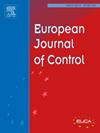海上机载风能系统中风筝与平台的相互作用:频率分析和控制方法
IF 2.5
3区 计算机科学
Q2 AUTOMATION & CONTROL SYSTEMS
引用次数: 0
摘要
本研究调查了深海抽水机载风能系统,重点是风筝与平台的相互作用。所考虑的系统包括一个 360 米长的软翼风筝,通过系绳与安装在 10 米深带四根系泊线的支柱上的绞盘相连。通过风筝的周期性轨迹和系绳的相应卷绕运动的反馈控制,将风能转化为电能。通过分析平台和风筝动力学之间的相互影响,以及不同的波浪机制,可以发现飞行模式对平台振荡的敏感性很小;另一方面,系绳力振荡的频率可能接近平台共振峰值,从而可能增加疲劳载荷并损坏浮动和浸没部件。为避免这一问题,提出了一种控制设计程序,作用于风筝路径规划器。模拟结果证实了该方法的有效性。本文章由计算机程序翻译,如有差异,请以英文原文为准。
On the kite-platform interactions in offshore Airborne Wind Energy Systems: Frequency analysis and control approach
This study investigates deep offshore, pumping Airborne Wind Energy systems, focusing on the kite-platform interaction. The considered system includes a 360 m soft-wing kite, connected by a tether to a winch installed on a 10-meter-deep spar with four mooring lines. Wind power is converted into electricity with a feedback controlled periodic trajectory of the kite and corresponding reeling motion of the tether. An analysis of the mutual influence between the platform and the kite dynamics, with different wave regimes, reveals a rather small sensitivity of the flight pattern to the platform oscillations; on the other hand, the frequency of tether force oscillations can be close to the platform resonance peaks, resulting in possible increased fatigue loads and damage of the floating and submerged components. A control design procedure is then proposed to avoid this problem, acting on the kite path planner. Simulation results confirm the effectiveness of the approach.
求助全文
通过发布文献求助,成功后即可免费获取论文全文。
去求助
来源期刊

European Journal of Control
工程技术-自动化与控制系统
CiteScore
5.80
自引率
5.90%
发文量
131
审稿时长
1 months
期刊介绍:
The European Control Association (EUCA) has among its objectives to promote the development of the discipline. Apart from the European Control Conferences, the European Journal of Control is the Association''s main channel for the dissemination of important contributions in the field.
The aim of the Journal is to publish high quality papers on the theory and practice of control and systems engineering.
The scope of the Journal will be wide and cover all aspects of the discipline including methodologies, techniques and applications.
Research in control and systems engineering is necessary to develop new concepts and tools which enhance our understanding and improve our ability to design and implement high performance control systems. Submitted papers should stress the practical motivations and relevance of their results.
The design and implementation of a successful control system requires the use of a range of techniques:
Modelling
Robustness Analysis
Identification
Optimization
Control Law Design
Numerical analysis
Fault Detection, and so on.
 求助内容:
求助内容: 应助结果提醒方式:
应助结果提醒方式:


